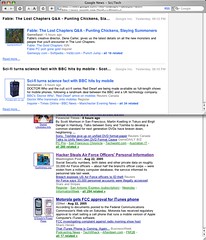 Image by Wysz via Flickr
Image by Wysz via Flickr In scholarly publishing, we have become accustomed to article titles like, “Prognostic Factors in Metastatic Breast Cancer: Successes and Challenges Toward Individualized Therapy.” Or, worse, something like “A Hot Day,” which might detail results from a probe to Venus and its new discoveries (don’t look this up, I just invented it, but I’ve seen plenty of things like it.) Long and polysyllabic or cute and unclear, our titles straddle today’s media uncomfortably.
Our titles should be thought of as headlines, since they are part of search results, feeds, and widgets in the same way that disparate stories dot newspapers. So, our headlines are long or cute because they presume that the reader is on the page, can see a related picture or longer blurb or clever design element, or is already part of a linear reading experience.
Today, online content has three audiences: people, social media tools, and search engines. Yet we write headlines solely for people, and often have the wrong reading environment in mind when we do so.
Here are some tips from a consideration of Web headlines done earlier this year:
- Web headlines appear in many places on a site. Web headlines can be syndicated with RSS to show up on many places throughout a site. For example, if a site wants to promote local news stories in the business sections, they can run an RSS feed of news headlines on a sidebar, which creates better chance of cross-section readership.
- Web headlines pop up on external sites. Through RSS, headlines can be syndicated on Google News, other news sites, blogs, wherever. This is great news because the more places your RSS feed appears, the more chances for increased readership you get.
- Web headlines don’t always appear with other content. Web headlines can’t depend on images or subheads to get readers to click them. Web headlines must be enticing enough to generate clicks.
- Web headlines can’t depend on text size for impact. Because headlines can be syndicated through feeds and often must fit in styles on different pages, it’s nearly impossible to depend on a headline’s size to grab attention of a reader. If size can’t do it, what can?
- Web headlines must get the point across. If your news sites’ headlines can appear anywhere on the web and without supporting content, it’s incredibly important to be able to convey the point of the story with just text.
- Your headline won’t necessarily be the headline people use. Believe it. Web users often share your stories on social media sites and write their own headlines for your content. The better headline you write, the less likely web users will have to edit your headlines to make them relevant to social media sites.
- You can change web headlines! If a headline you wrote for the morning’s story doesn’t seem to say the right thing about the story, you can change it any time. On the web, you can edit any content in real time, including your headlines.
Writing a blog, I’ve learned again the power of the short headline. The widgets, RSS feeds, and search optimization the blogs benefit from demand it. The URL of the post demands it. Clarity is possible in few words. Puns aren’t very effective.
I’ve had entries go from dogs to stars in the stats with a slight headline alteration, usually an improvement toward clarity.
Because a blog is a web-native publishing environment, the pressure for a long, elaborate headline is gone. The entire article is searchable and linkable. So, instead of, “Prognostic Factors in Metastatic Breast Cancer: Successes and Challenges Toward Individualized Therapy,” I might write, “What Will Help Your Breast Cancer Patient Most?” (Counting spaces, 47 characters vs. more than 100, a >50% reduction.)
Short, clear, brisk. On the web, content presentations tend to be smaller, so space is at a premium.
I will be impressed when editors in STM publishing start writing headlines for online consumption (RSS feeds, widgets, blogs, and iPhone applications). This will probably improve headlines in the print medium as well.
Until then, prognostic factors for publisher success in new media spaces may be influenced negatively by macroenvironmental forces beyond the control of the acting agent.
In other words, new media players will eat our lunches.
Discussion
2 Thoughts on "Headlines 2.0"
Overall I am in agreement, but you also have to take into account the level of scholarship of the material and the audience. In the medical field, a title of “Prognostic Factors in Metastatic Breast Cancer: Successes and Challenges Toward Individualized Therapy” is going to be received quite differently than “What Will Help Your Breast Cancer Patient Most?” If you are targeting physicians, I think the original title and will receive more attention.
![Reblog this post [with Zemanta]](http://img.zemanta.com/reblog_e.png?x-id=ff2058c8-3833-49d7-9e78-5e8e87681957)


